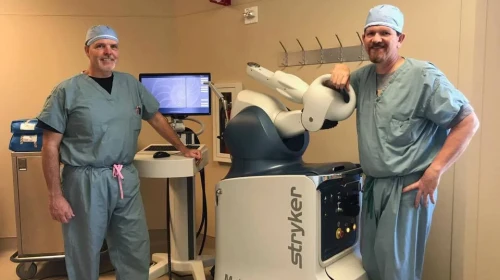A total knee replacement, also known as a knee arthroplasty, is a well-established procedure for restoring mobility, function, and comfort to an arthritic knee.
What is it?
A total knee replacement, also known as a knee arthroplasty, is a well-established procedure for restoring mobility, function, and comfort to an arthritic knee.
HOW IT WORKS
Contrary to popular belief, during a total knee replacement, the entire knee is not cut out. Only the damaged and arthritic portions of the femur (thigh bone) and tibia (shin bone) are removed, using special cutting guides, leaving as much bone behind as possible. Then, metal implants are sized and selected to replicate the original bone surfaces in a healthy knee joint. The implants are secured to the ends of the femur and tibia with bone cement or using a press-fit technique which allows your bone to grow into the implant. Once the metal components are secured, a high-density plastic (polyethylene) spacer is inserted between the two bones, acting like cartilage. Lastly, the patella (kneecap) is resurfaced with a plastic button to remove and address arthritic bone on the kneecap.
Non-surgical Treatment
Non-operative
treatments and medications are highly recommended for younger patients
before considering a total knee replacement. Older patients tend to
have more reliable outcomes with total knee replacements; however, the
procedure has also been successful in younger patients. Patients with
knee arthritis who have failed to see improvements in their pain and/or
function after non-operative treatments are great candidates for a total
knee replacement.
Back to Knee








